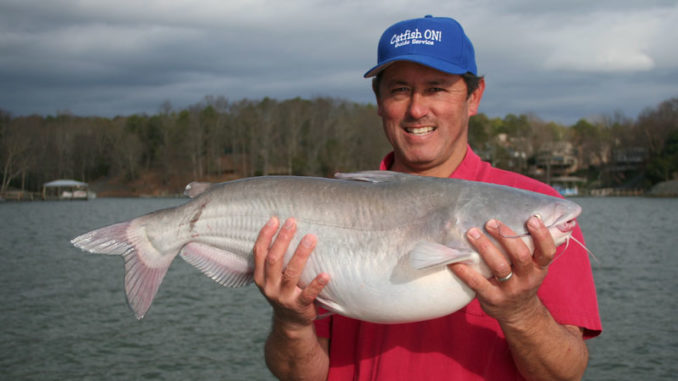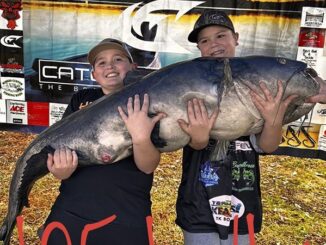
Big blues heading to middle, lower end of SC reservoir, guide says
As the weather transitions in late September from the last gasp of the hot, humid summer to the more moderate temperatures, the blue catfish in South Carolina’s Lake Wateree also transition. They move to the middle and lower sections of the lake, according to veteran guide Catfish On‘s Rodger Taylor of Rock Hill, S.C.
“Catfish can be caught on Lake Wateree from Cedar Creek to the Wateree Dam any time of year. But drifting the middle to lower lake in fall usually produces better numbers, as well as good-sized fish,” said Taylor (803-517-7828).
The right bait is a key element to catching Wateree blues, he said. And gizzard shad are plentiful and easily caught with a cast net.
“The perfect size bait is 4 to 5 inches long. And they are usually abundant in the major creeks,” he said. “Look for bait early or late in the day when the water is still like glass. Gizzard shad can be seen popping across the water.”
White perch and bluegills are also excellent baits. Anglers can easily catch them with a light rod and reel, he said.
“White perch and bluegill heads seem to entice larger blue cats and should always be included when fishing for cats in the fall,” Taylor said. “Shad is probably the best all-around bait on the Catawba chain of lakes. But a variety of baits seems to put more and bigger fish in the boat in late September on Wateree.”
Taylor said fish are often scattered this time of year. So drift-fishing, Santee-style, is the most-effective approach. This method allows the angler to present more baits to more fish by covering a great deal of area.
Changes in the bottom are catfish magnets
“Concentrate efforts by drifting across vertical changes in the bottom,” he said. “Small humps or creek channels on large flats are magnets for catfish. The large flat at the mouth of June and Rochelle creeks is a great example. It is 20 to 22 feet deep, with numerous small humps and depressions. The flat usually holds large schools of gizzard shad, which bring the blues. Finding a sweet spot is obvious when more than one rod goes down while drifting.”
Similar flats are located outside of Beaver Dam and Colonel creeks, he noted.
Anchoring and putting out baits will also produce, Taylor said, if you fish the same humps and hidden creek channels on flats.
“Humps sometimes contain mussel beds, and that is a definite plus,” he said. “The river-channel ledge is also an excellent place to anchor. Fan-casting baits to different depths makes the percentages better for hooking a cat.”
Taylor also noted that GPS electronic topo maps such as Navionics or CMAP are indispensable tools for finding good underwater structure to fish, whether drifting or anchoring.
“Expect to catch large numbers of blue cats in the 3- to 8-pound range, with an occasional large fish in the 20- to 40-pound range,” he said. “Some days in September and into the fall are definitely better than others. Passing fronts with rain fish exceptionally well while the front is moving through. Wind really helps the drift bite, concentrating bait and fish and may even eliminate the need for a trolling motor. But you will need a drift sock.”



